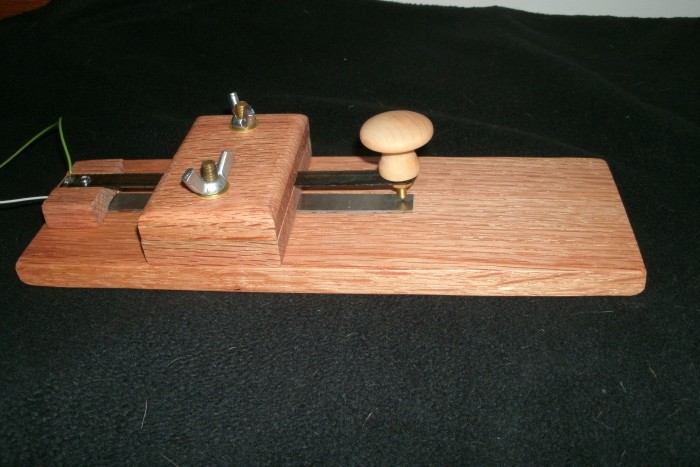[Today’s run: rest day]
On New Year’s Eve every year the ARRL hosts a ham radio operating activity called Straight Key Night.
A key is a hand operated switch for sending morse code. Here’s a webpage with pictures of a common type.
I usually use something called a keyer, which consists of a set of paddles and an electronic gizmo. Pushing it one way produces strings of dits. Pushing it the other way produces strings of dashes (dahs). So I just rock my hand left and right and the code comes out well formed. A straight key requires a bit more manual intervention. You push down when you want eeeee and you let up when you want silence. So the longs and shorts, dits and dashes, are made by how long you hold it down.
I decided I would like to try operating on SKN if I am able. But I don’t have a straight key. So I decided to try to build one. I thought about different ways of doing it. I am not a machinist, so the fancy stuff is out. My woodworking skills are modest also. But I came up with a design that turned out ok.
The spring part is an old standby: a used hacksaw blade. I have three layers of a 1/2″ oak board. The middle layer has two U-shaped slots put in it using my router, one on the top and one on the bottom. The depth of the slots fits the thickness of the metal pieces. The top and bottom act as a clamp. The top slot holds the hacksaw blade. The bottom slot holds a piece of PCB material (tinned with solder, so it shows as metallic silver in the picture). I used some small screws and a second slotted piece in the back. By moving that piece backward and forward I can adjust the length of the springy part and of the pcb in tandem. That changes the action of the key but keeps the two parts in the same relationship. When more of the blade sticks out, the action is softer.
I purchased some brass hardware at Lowes. A screw and a couple of nuts along with a plain wood drawer handle act as my knob and the electrical contacts. I can adjust the width of the opening quite a bit.
I have used my new key to make three contacts so far, all on the 40 meter band (7 mHz) using my TenTec Century 21 transceiver. I have to go pretty slow. But the other guys seemed to understand me ok.
Now, this construction would not have worked at all before about 20 years ago. That’s because modern radios are set up to use a smaller voltage between the keying contacts. In the way-olden radio days, before maybe 1925, they would be keying with a whole lot of voltage and current on the key contacts. Then up until the 1970’s there would have been something like 150 volts on there. Now days it is more like 12 volts. In those high voltage situations you would -NOT- want to have both conductive pieces right there where your hand is operating. Or at least I wouldn’t. Many old keys have a large bakelite disk-like thing under the knob so that you wouldn’t touch any of the metal at all.
Parts: 1/2″ red oak board from Lowes; old hacksaw blade; piece of PC board material; drawer knob; various screws, washers and nuts; a couple of pieces of wire.
Tools employed: saw, router, dremel cutoff tool, drill, soldering gun. It would have been handy to have a router table, but it turned out ok. The wood was finished with some sanding and a bit of wipe-on polyurethane.
